Marquette Golf Club (Greywalls)
MI, USA
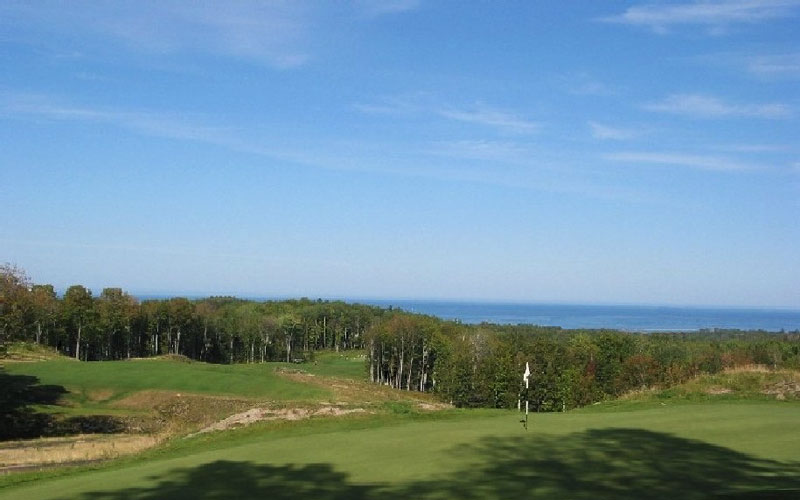
Golf in Michigan’s Upper Peninsula: The 9th green with the 1st fairway beyond.
A common excuse for much of today’s golf course architecture is that the “old guys” were given the best property to work with, while today’s designers are left with table scraps. Such a belief prevented questions being asked about what yesteryear’s architects would have done with today’s property (and environmental and other) restrictions and what today’s architects would have done with the prized sites many architects enjoyed before World War II. The latter question has been answered with designs such as Sand Hills and Pacific Dunes, which occupy sites as fine if not finer than those enjoyed by MacKenzie, Raynor, et al. The former question is an ignorant one, as it makes the faulty assumption that previous generations of architects were blessed with nothing but ideal pieces of property. Have people forgotten about the great engineering feats and expense that went into carving Yale out of the New England rock and creating Lido out of the water?
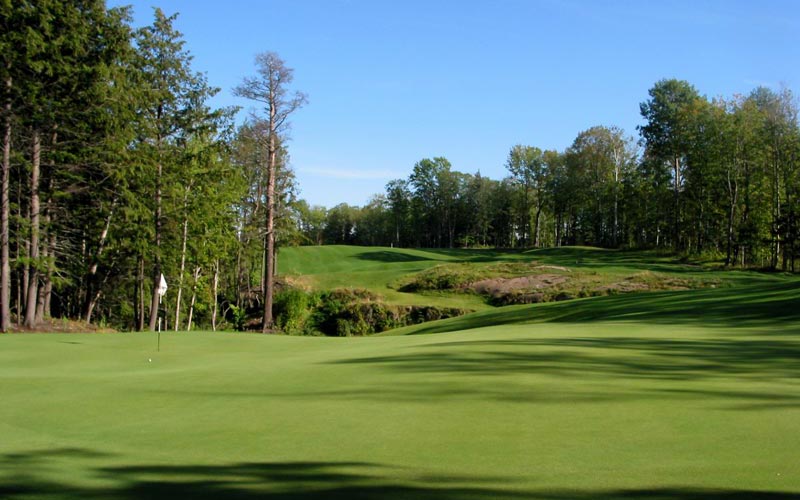
The wild undulations of the 2nd are Nature’s work.
The Greywalls Course at Marquette Golf Club offers a glimpse at what the revered architects might have designed in today’s world. Its site is demanding, but with the potential for an intriguing course somewhere among the rocks, trees and severe elevation changes. Architect Mike DeVries agonized over the routing for the course to show off the many natural features of the property while at the same time downplaying the obstacles the severe site presented. Despite the imposing site, DeVries showed restraint in the amount of earth (and rock!) moved, as only 40,000 cubic yards of dirt was moved and 3000 cubic yards of rock was blasted. What he accomplished was technically possible in the 1920s. The result is a dramatic and rough design that always reminds the player of his environment while also imposing many strategic questions. As DeVries describes the routing challenge:
The routing for the course was very difficult, in that I had to find good golf holes that fit together and produced a good rhythm and flow to the course and not just one ‘wonder-hole’ after another, with rock everywhere and views of Lake Superior. That was the biggest challenge, to not make it too dramatic and make sure it was good, solid golf. There are 233 acres that I had to work with, but much of that was not usable due to wetlands, a trout stream, rock ledge and outcroppings, and severe slopes (sheer rock walls). These restrictions dictated how some holes could or couldn’t be developed and led to the routing of 4-7 teebeing what it is. I needed to transition from the low valley of #4 (a natural hole in either direction as a par 4 or 5) up to the ‘Middle Plateau’ where 1 tee, 9, 10, 11 tee, 17, and 18 tee are located. Getting down to the ‘Valley Holes’ (#11-16) was an easy proposition with a big downhill drive on the 11th that everyone would enjoy. There were numerous other fine holes on the property but there really isn’t much unused space and certainly not enough room for a full driving range without acquiring some adjacent land. I am very pleased with the routing, as I think the Lake views come appropriately throughout the round (1 tee, 7 tee, 9-11 tee, 17-18 tee) and not constantly. Likewise, the rock outcroppings serve as hazards, dictating strategy, and the rock walls like at 5 greenare dramatic and yet work very well agronomically, due to orientation and tree removal. Therefore, it is a good mix of views, features, strategy, and the golf always shines — that makes me very happy. The construction cost for the course was $2.7 million, not including cart paths, which were added a year later.
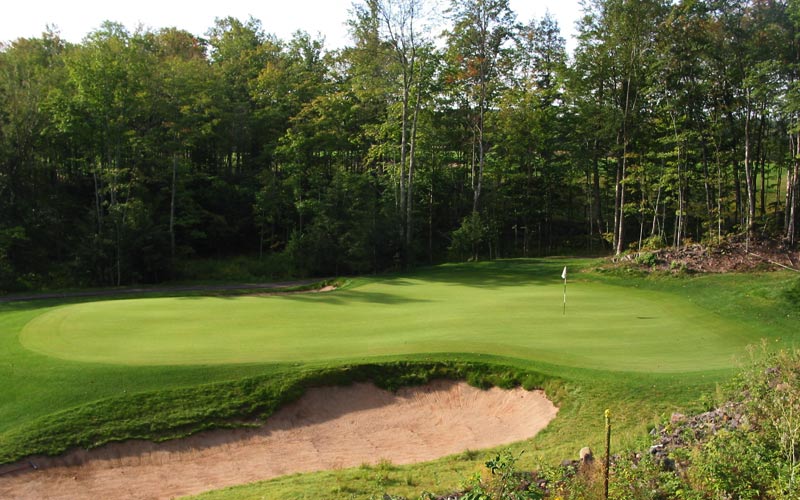
As seen from the right, the 8th green is well integrated into its rough and natural setting.
Perhaps more so than any other course in the United States, Greywalls demands thought from the tee of straightaway holes. People often associate strategy with holes that bend one way or the other, but at Greywalls there is an unusual number of straight holes requiring much thought as to both club selection and direction. As shown below, holes such as 4, 7, 8, 10 and 18 offer several options that, even after several rounds, the author is still not comfortable with or certain which is the best play off every tee – an imminently desirable trait that keeps the golfer coming back for round after round.
Holes to Note
1st hole, 580 yards: While the prospect from the 1st tee is dramatically beautiful (e.g., with the famed Pictured Rocks55 miles away often visible), the first is much more than just a pretty hole, and it sets the stage nicely for what lies ahead. With the nearby 10th tee, the 1st tee occupies one of the highest points on the property and has the golfer immediately drooling to start his round. To his left he can determine the hole location for the 9th and well below to his right he can see the 18th green and start thinking about how best to attack that day’s hole location. In front of him lies a long, rough, tumbling three-shotter. There is an appropriately wide fairway for the tee shot beyond the ravine, but once there the player already faces a key decision, as the green is usually out of reach in two: (1) Should he play a 4-iron short of the ridge that cuts across the fairway 80 yards short of the green, realizing that this tack will often result in a blind pitch to the difficult green, or (2) should he risk a fairway wood to knock his ball over this ridge, to leave him a short pitch to a fully visible green? Whatever length approach the player has left, the pitch immediately sets him on edge, as the green slopes away on all sides and has some challenging interior undulations as well. The low-handicapper is often pleased to find the green some 20 feet from the hole.
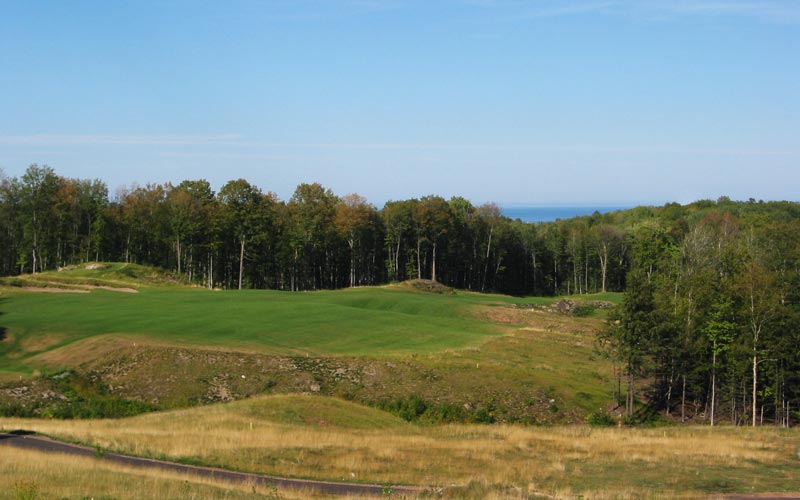
Let’s play golf! The opening tee shot.
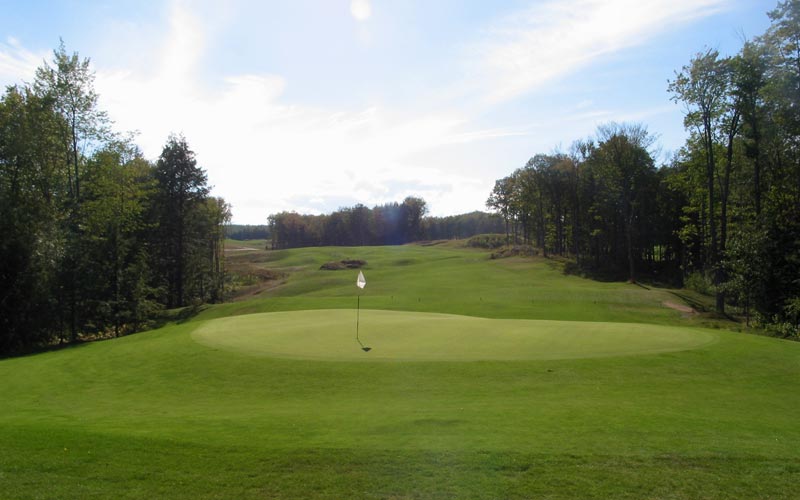
Even with a wedge in hand, the 1st green is a challenge to find (and stay on), as this view from behind the green shows.
2nd hole, 425 yards: The 2nd fairway is one of he author’s favorite walks in golf, as it is fun simply to walk up and down the tremendous undulations. The approach is one of the more precise on the course. At first look, the key to the approach appears simply to be negotiating the ravine in front of the green (which is nowhere near as fearsome as it looks), but subsequent rounds will makethe golferrealize that it is the undulations of the moderate-sized green that dictate the play. The green has two levels, stepping down from the left. The left (upper) shelf would seem easy to find, given the large left to right portion of the fairway left of the green, but the slope is so severe and the upper shelf is narrow enough, that a ball landing left of the green will often find its way to the right (lower) part of the green. This hole captures the allure of Greywalls: A ruggedly natural hole with the barely discernible finishing touch of an accomplished architect.
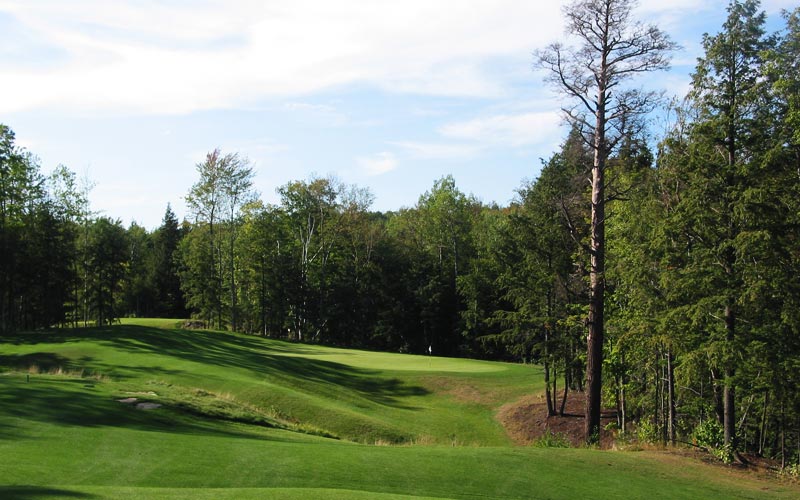
The approach to the sloping 2nd green beyond a ravine. A ball landing ten yards left of the green could finish to the right of the green.
3rd hole, 175 yards: This hole currently stands at a sort of intersection, with carts carrying golfers from and to the distant (original) clubhouse out to the 1st tee of Greywalls hurrying past. When the new clubhouse is built behind the 18th green of Greywalls and this traffic ceases, the third will be better appreciated as a calming hole in a peaceful corner of the course following the bold opening two holes.

The peaceful corner of the 3rd with its wetlands.
4th hole, 425 yards: The fourth, on the other hand, attacks the golfer right away with its bi-level fairway. The higher (left) side offers a shorter and slightly downhill approach, while the lower (right) side offers a longer approach but right up theaxis of the right-to left angled green. The left is certainly the more difficult to find, but, even after six rounds, the author is still not sure which is the better play off the tee.
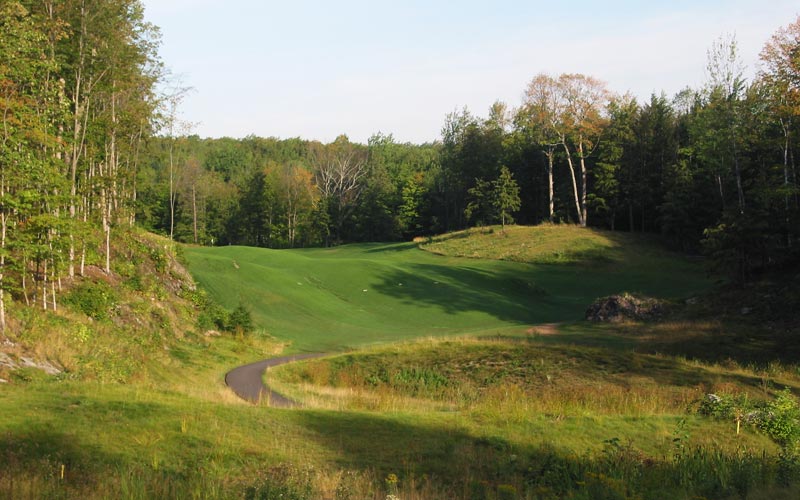
The tee shot on the 4th: Left or right??

The difference in elevation between the left and right sides of the fairway off the tee is evident looking back down the fairway.
5th hole, 310 yards: While admittedly a “forced” hole between the fourth and sixth (e.g., given the long walk back to the tee just to stretch the hole to this length), the fifth is one of the most intimidating holes of its length the author knows. From the tee, the prospect is less than encouraging: A carry of 190 yards uphill across a ravine to a narrow fairway that slopes from left to right, with the hole bending from right to left. A large rock outcropping is on the left, with dense woods (and a likely lost ball) to the right. On a hole of this length, a player can often play a shorter club off the tee to ensure avoiding trouble, but that is not an option here, as at least a 3-iron is needed just to reach the fairway. The pitch is then to an undulating green wedged between an outcropping on the left and sheer rock wall on the right. After several rounds the player may well conclude that a driver toward the green is actually the safest play off the tee.
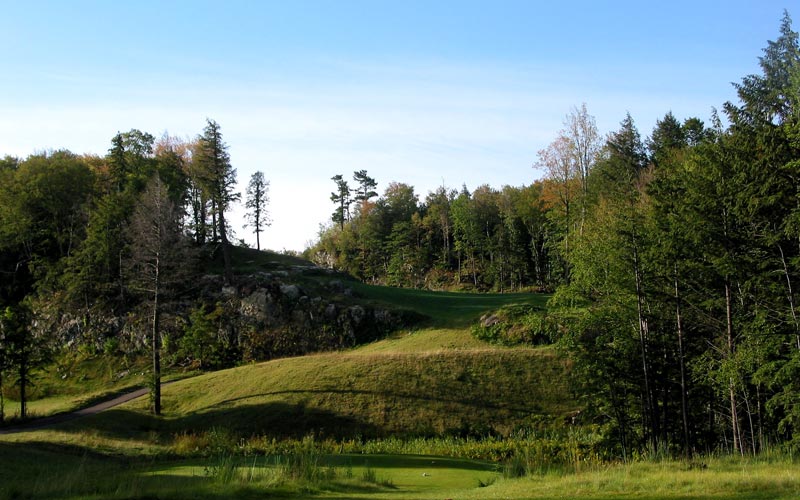
The tee shot at the 5th: More than a bunt is needed.
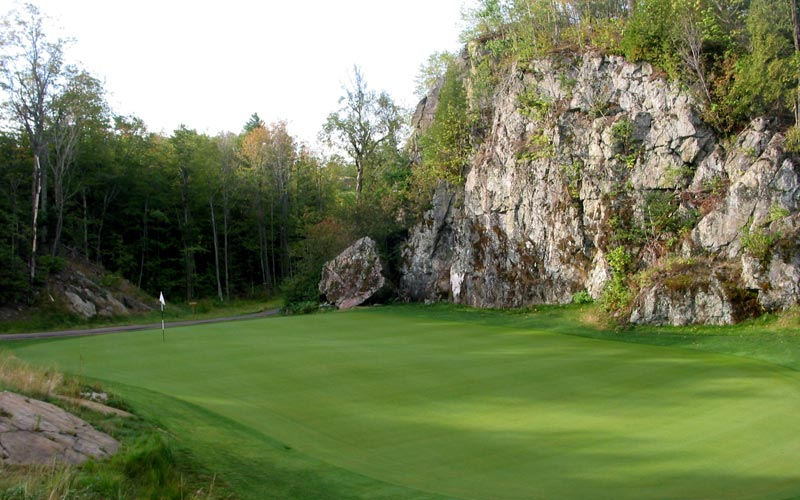
The 5th green nestled between rock outcroppings.
6th hole, 190 yards: As this has been the most photographed hole of the course to date (largely because the exposed rock walls illustrate that the course’s name came from the natural features of the site rather than the hotel at Muirfield), the author is tempted to dismiss the hole for its attraction to the masses. However, this snobbish view must be abandoned, because this visually-dramatic hole is also a demanding one to a cunning green in a natural green site. The long or middle iron across the chasm is made even more demanding with the knowledge of the false front and the severe back to front tilt of the green. The player feels compelled to play toward the back of the green, but he could well then putt off the green from there with a front hole location. DeVries’s account of how he ‘found’ the 6th:
The 6th was a naturally made hole just sitting there to be taken, but it caused quite a bit of consternation at first. When I first got to Marquette, everyone would ask me, ‘Have you been to the Rock?’ and I would say, ‘What rock?’ Well, it meant the tall, bald peak that is above 5 greenand 6 tee. I went there on my first visit on the property and the view was amazing, as it is today. Of course, everything was covered with trees but I knew I had to get to this spot sometime in the round, so later on, as I was searching around for a how to get from the lower valley at #4 and up to the Middle Plateau, I was able to feel out the 6th greensite and figured this was a natural hole just waiting for me and it was a bit extreme but so was the site and this just ‘fit’ too well — everyone would want to try to make that shot! It is rugged, fits in with the site, and makes for a great hole — now it is liked by everyone (at least I haven’t heard any negatives in the lasttwo years).
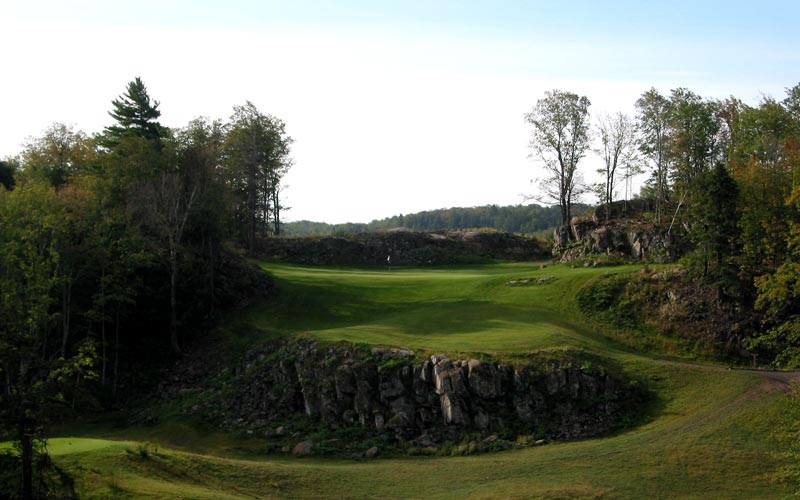
From the 6th tee it is evident how the course came by its name — from the rock outcroppings that look like, well, grey walls (and not from a hotel in Scotland).
7th hole, 490 yards: From the tee the player feels as though his reaction should be “Wow! What a view of Lake Superior,” but instead he thinks “Where in the world am I supposed to drive the ball?” as he sees the landing area with a sharp drop-off to the left (with a sliver of fairway there) and rock at the far part of the landing area. The two basic choices are (1) to play a 3-wood to the visible part of the fairway, leaving a downhill approach of 200 yards, or (2) blasting driver over the hole, in the hope that the ball does not get hung up in the rock, leaving a semi-blind approach of 160 yards. The green is one of the largeston the course at 7000 square feet, an appropriate size given the distant view of Lake Superior. Like Coore and Crenshaw did with the 18th green at the Plantation Course at Kapalua, DeVries built a large green to fit the setting and to accommodate a great variety of length approaches.
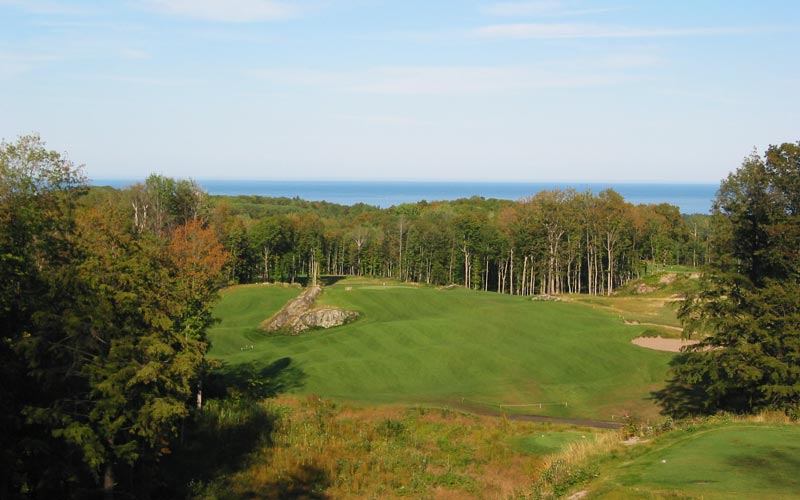
The tee shot on the 7th: To hit driver straight (toward the green, whose back portion is just visible) or 3-wood to the highest point of the fairway?
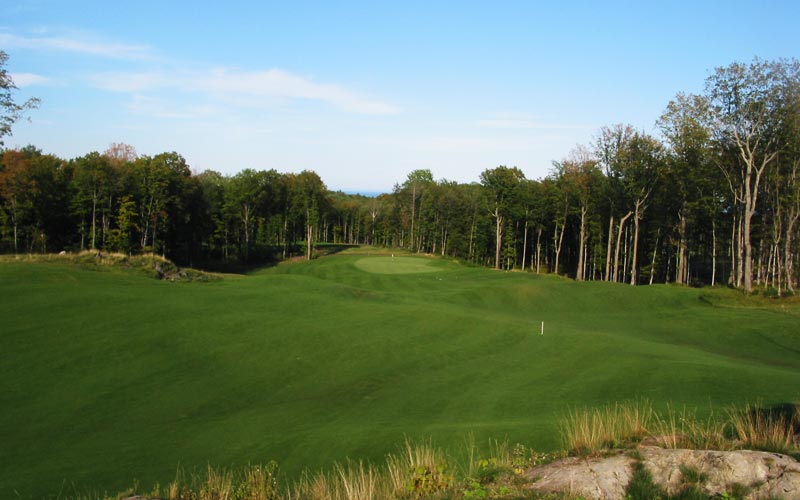
The downhill approach to the 7th, from the front edge of the top part of the fairway. Not a bunker to be found.
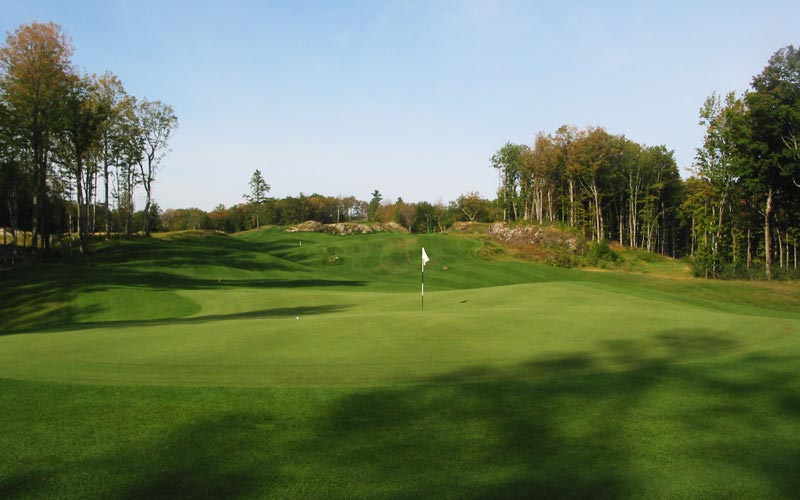
Looking back up the 7th from its large, undulating green.
8th hole, 345 yards: Despite its modest length, the 8th has quickly established itself as one of the more intimidating and challenging holes on the course, as evidenced by the fact that it played as the 6th most difficult hole in the stroke-play portion of the 2006 Club Championship. Up to the 220 yard mark off the tee, the fairway is alarmingly narrow, exacerbated by the right-to-left slope of the fairway. Beyond 220 yards, the fairway levels and widens a bit. The experienced player will therefore have two choices from the tee: (1) to play a 6-iron, followed by another 6-iron to the green, or (2) to bang a driver. The severe slope leading up to the green (from which an approach that is just short of the green can come back a full 20 yards) can make a 50-yard pitch most difficult. All of this adds up to an original hole: A short, straight two shotter that does not rely on sand or water where a good player is happy to walk away with 4.
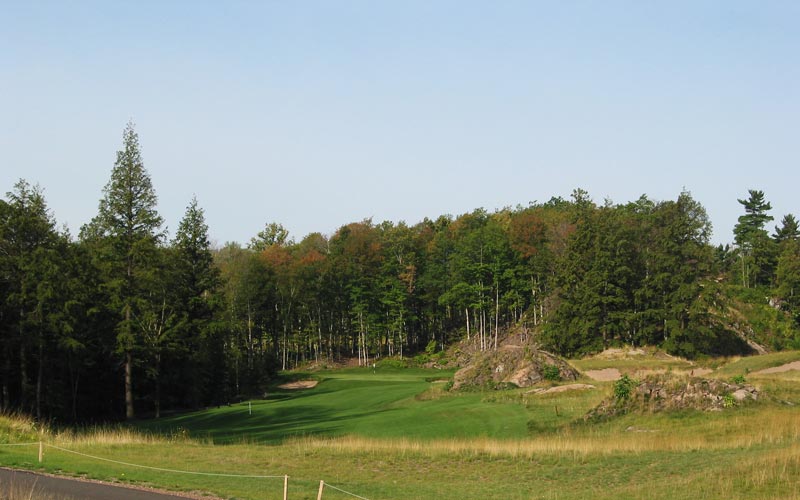
Is there a fairway out there? The tee shot on the 8th.

The options for the tee shot on the 8th become more clear when looking back down the fairway, which widens out to the golfer’s right beyond 220 yards.
9th hole, 390 yards: The player’s attention will first be drawn to another view of Lake Superior, but subsequent rounds will have him scratching his head over how to play this demanding hole. With the large bunker on the left some 240 yards off the tee, the player has to decide whether (1) to attempt to carry the bunker with a driver, (2) to play 3-wood just to the right of the bunker, (3) to play a shorter club toward the bunker, leaving a good angle to the green that slopes from right to left but a completely blind shot or (4) play a shorter club out to the right, leaving a longer approach and from a difficult angle, but with some of the green visible. The green is benched into the hillside, and the drop-off to the left (where a ball that just misses the green can finish 40 yards from it) makes the approaches from the right all the more risky.
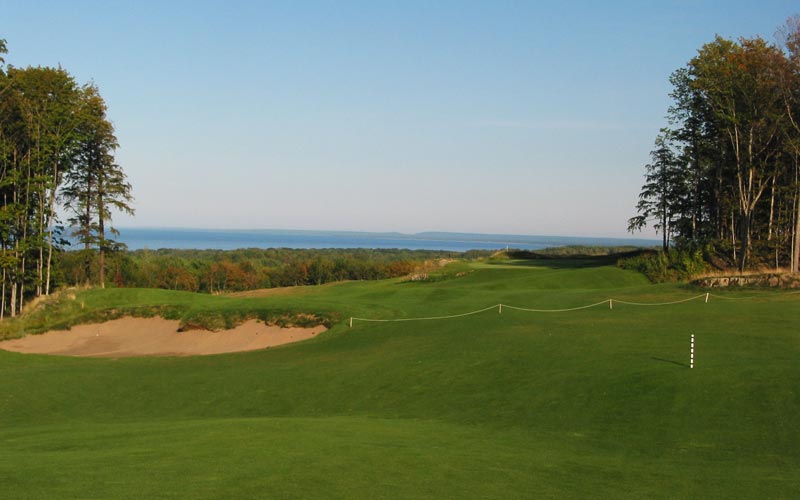
The bunker at the 9th that presents such a dilemma off the tee. While this might look like a nice approach, this picture was taken from 180 yards out, in the right side of the fairway — a very difficult spot from which to hit and hold the right-to-left sloping green benched into the hillside.
10th hole, 335 yards: After an arduous first nine of hill climbing, the tenth seems like a respite: short andstraight with awide fairway and just one bunker on the entire hole. This hole has proven to be a sleeper, with many underestimating its demands. Sure, a player can hit driver from the tee and still find the fairway after a push/slice of 40 yards, leaving him with less than 80 yards to the hole. However, he now faces a semi-blind or completely blind approach to a green angled the “other” way (from left to right). A driver down the left side (near the rock and tall rough on that side), on the other hand, will leave a much more straightforward pitch where the player can realistically think about making a 3. The author once noted with interest how one of the better players of the Club laid back in the wide fairway to 140 yards.
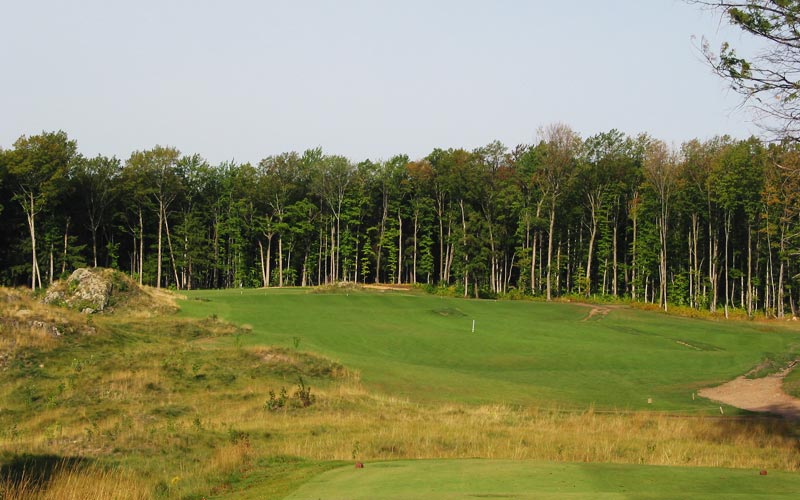
The tee shot on the 10th looks (and is) wide open for such a short hole, however . . .
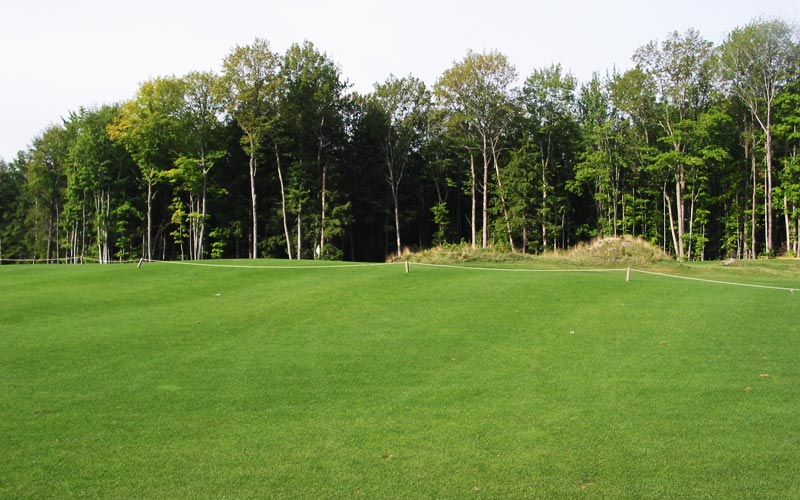
. . . a safe drive down the right will leave an awkward angle for the pitch and, depending on that day’s hole location, a semi-blind or blind approach, while . . .
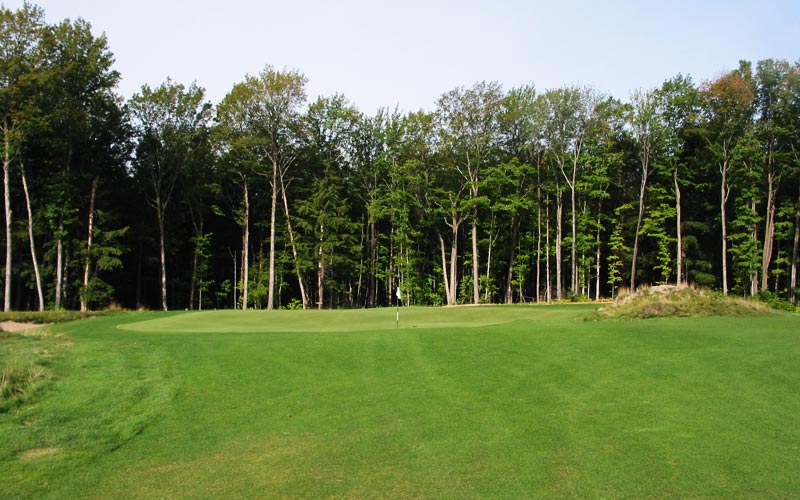
. . . a brave tee shot down the left leaves a much more straightfoward pitch.
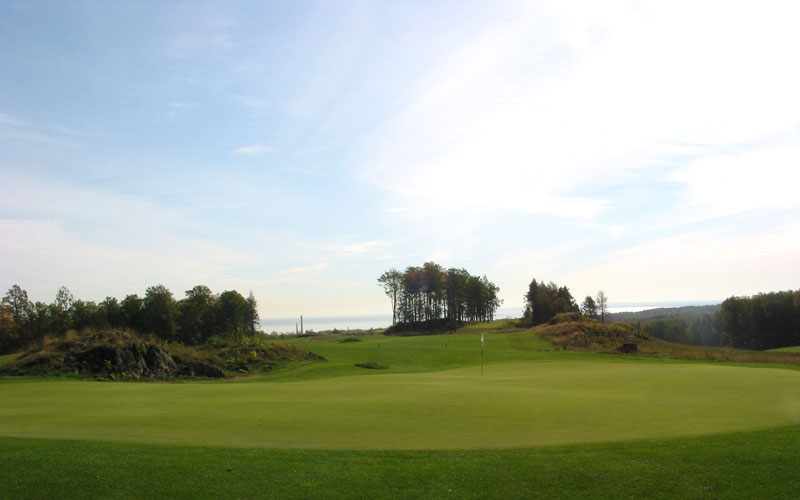
The angled 10th green, seen from behind, reinforces the desirability of a drive down the left side of the fairway.
11th hole, 390 yards: Many visitors have commented on the attractiveness of the bunkering by DeVries at the Kingsley Club, yet there has been precious little bunkering so far at Greywalls, as the demanding terrain (with its rock outcroppings and contours)does not need help in defending itself. Therefore, it comes as a bit of a shock for the player to see someeight bunkers (out of the course’s 36 (of which ten more come at the 13th)) cut into the heaving fairway from the 11th tee. Once again the player must decide what to do, with the popular choices being to hit driver left of the central bunker (leaving a 100-yard pitch) or to play 3-wood to a flat spot short of the central bunker, leaving a completely blind 150-yard second. While the putting surface is visible rarely for the approach, the green, while set in a punchbowl, is not an overly welcoming target, especially when the hole is located in the narrow back.
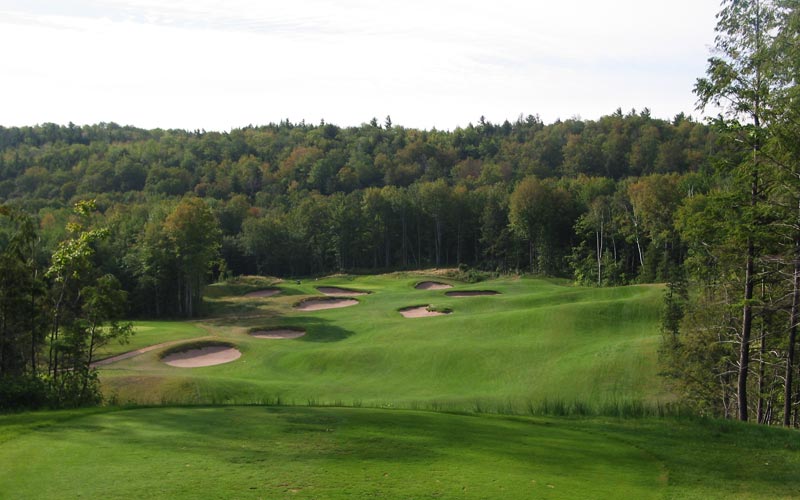
Bunkers galore: The profusion of bunkers (especially the one in the center of the fairway) on the 11th hole forces the player to make yet another strategic decision on essentially a straight hole.
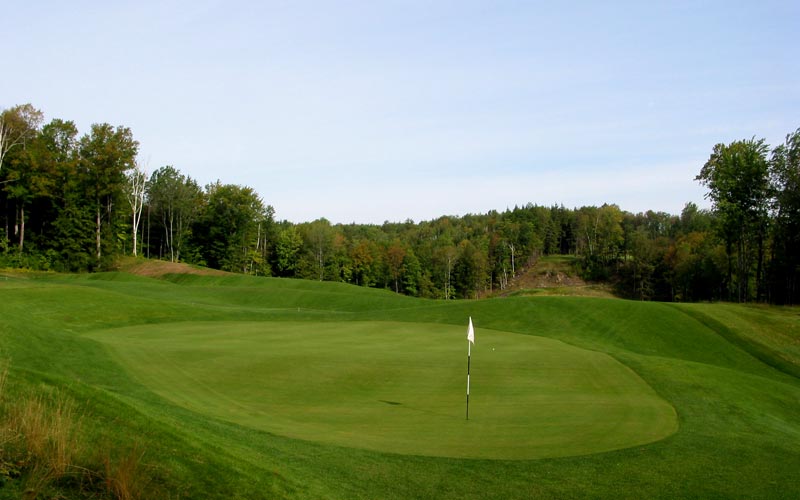
The semi-blind green (from behind) allows the player to use the slope on his right to bounce the ball onto the green, while the drop-off on his left must be avoided – a classic example of a green with one side to favor and one to avoid.
12th hole, 490 yards: After his senses were bombarded with bunkers from the 11th tee, the golfer now almost feels lost on the 12th tee, as the gently rolling fairway is a full 50 yards wide, with no bunkersorrock to be found from the tee. Yet, this first look of a “normal” golf hole and the length of the hole can often fool the player into swinging from his heels. (Confession: In six rounds the author has three times driven into a clump of trees on the left.) This hole begins a stretch that was built entirely on sand and whose parallel fairways (12, 13, 14 and 16) offer a welcomed intimacy after the more isoltaed holes of the first nine.
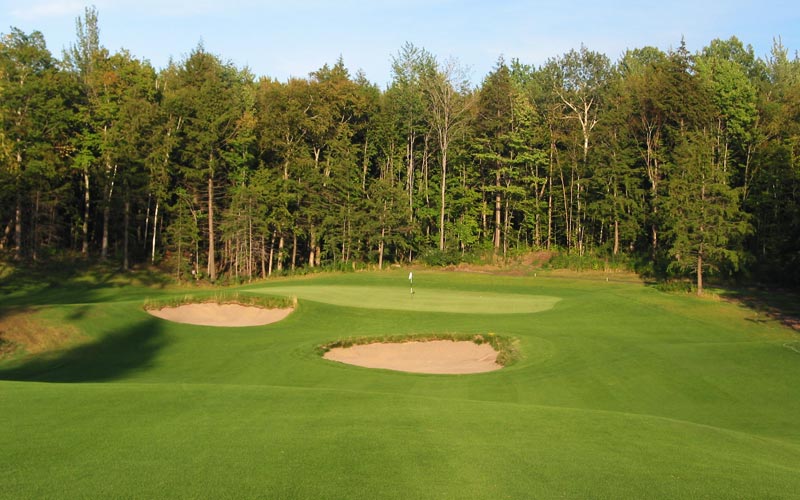
The relatively open 12th green encourages a bold swing with the long approach. The bunker in front is very much in play after a missed tee shot (or into a strong wind).
13th hole, 560 yards: Perhaps the favorite hole of DeVries, the 13th demands three good shots to make five. The hole iscapped with the wild green, which offers a near-horizon target for the approach and a wide variety of recovery shots and putts. The front-left bunker rewards a second shot down the right side, close to the drop-off to the 14th hole, and the expanse to the left of the green fools players into missing the green there, leaving an extremely difficult recovery.
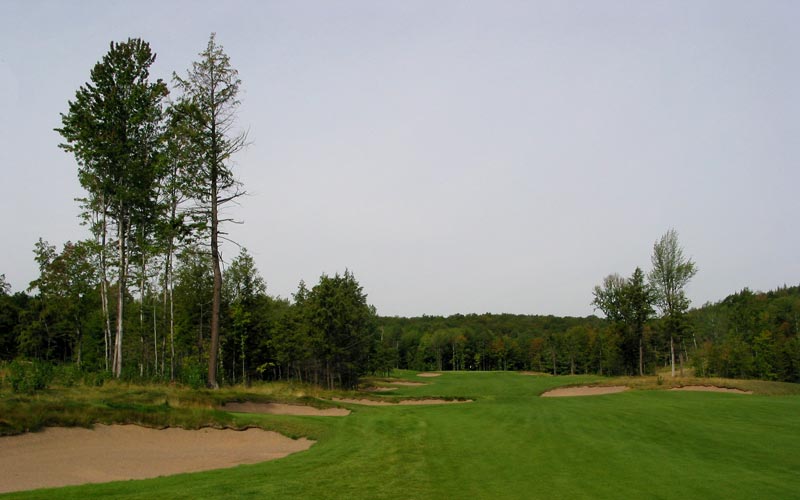
The long 13th, with bunkers to be avoided with every stroke.
14th hole, 450 yards: With the green angled from right to left and starting off at fairway level but then dropping off left, right and behind, the approach to the fourteenth is the author’s favorite shot on the course. While the green itself is fairly straightforward, its edges slope off just enough to make finding this green with the second shot quite an accomplishment. On the short list of best bunkerless holes.

The approach to the 14th features the wetlands on the left and the elusive, angled green.
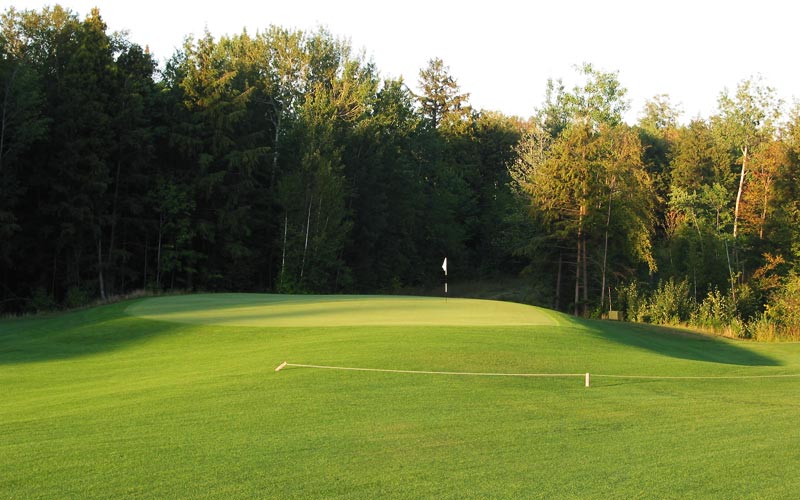
As seen from short and right, the 14th green is set at an angle, falling away on all sides beyond the front.
15th hole, 240 yards: After four holes away from the rocks, the 15th brings back the feature in a big way, with the hillside of rock just paces to the right of and beyond the green.
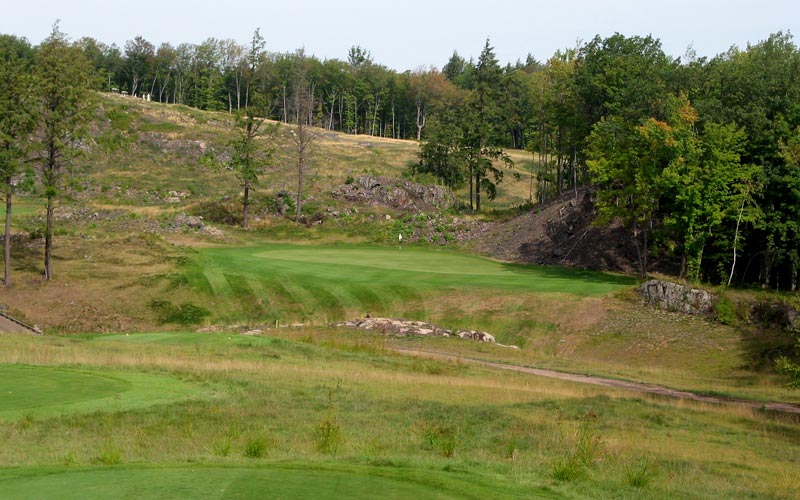
With punishment for a miss long or to either side, the 15th fortunately offers plenty of room short of the green.
16th hole, 370 yards: On this dog-leg to the right, the player is tempted to cut off some of the rocky hillside to the right with a driver to leave a pitch to this firm green, but the wetland on the left and the left to right angle of the fairway beyond the 240-yard mark require the player who selects driver to remain committed to the bold line, as a last-minute bail out to the left will result in trouble. The green appears to be an homage to a Donald Ross one: square in shape with raised side and back and a trough up the spine.
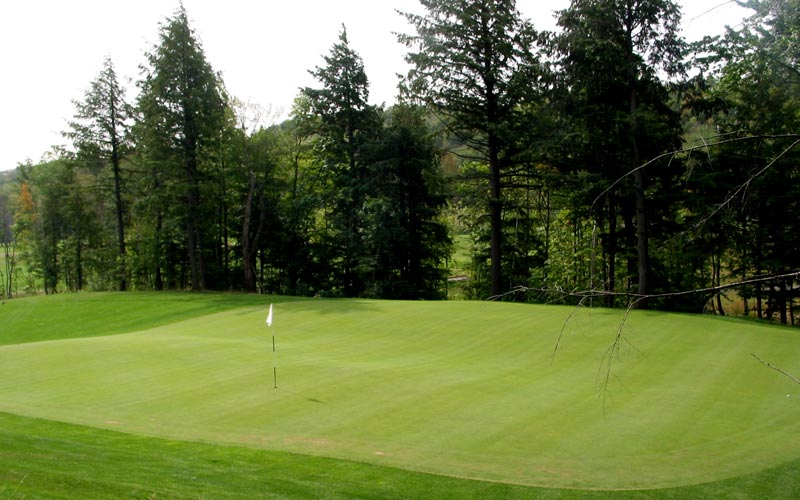
The square, Ross-like 16th green with its central swale as seen from the back-right.
17th hole, 135 yards: This should be simple enough: a short-iron over level ground to the largest green (almost 10,000 square feet)on the course. The catch, of course, is the green, which is angled and features some of the fiercest undulations on the course. From the nearby 11th tee the wise player will survey the hole location on the seventeenth and start thinking about his play there.
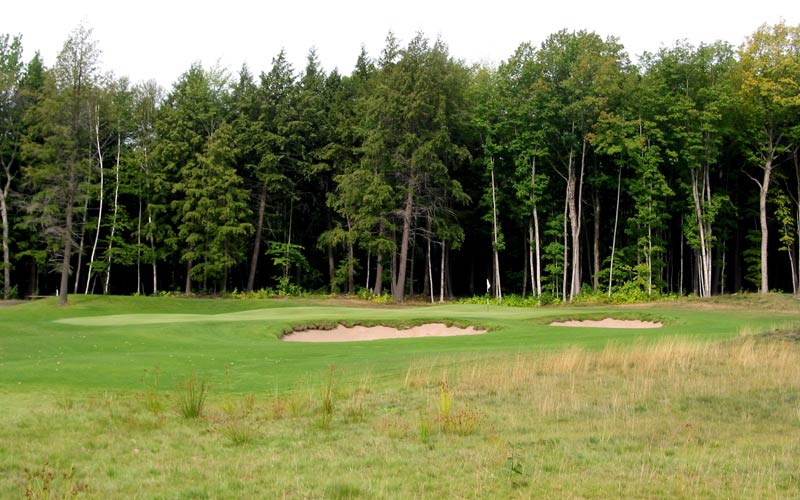
From the tee it seems unimaginable to miss the huge 17th green . . .
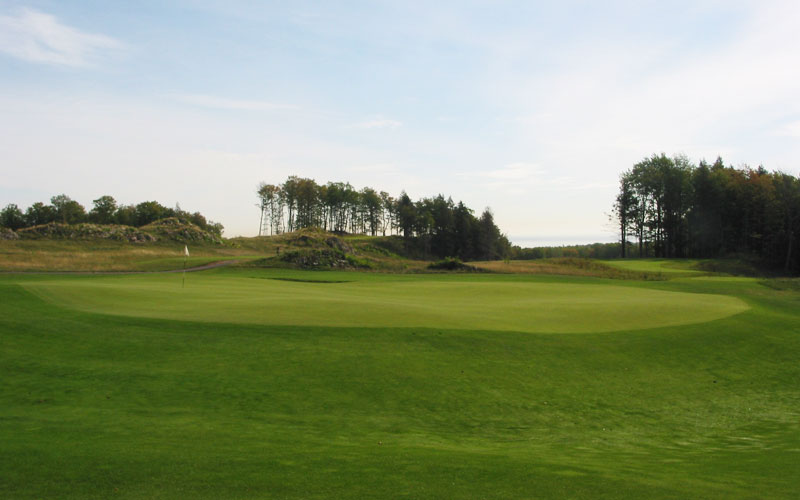
. . . but this view from behind shows how making a 3 is not merely a case of finding the green off the tee. DeVries was thrilled to find this swale left and behind the green in the trees and made it a key feature in the hole.
18th hole, 535 yards: An intriguing hole that has surprisingly become the most criticized (or perhaps least understood) hole at Marquette, the eighteenth has the elements of a memorable finishing hole: A view of Lake Superior from the tee, strategy with the tee shot, an interesting green and the opportunity to walk away feeling good about golf and life in general. What’s there not to like? The downhill tee shot to a cascading fairway does narrow at the 310 yard mark to 22 yards (similar to a fairway at the U.S. Open), but the fairway plays much wider as the slopes on either side funnel the ball toward the center. From there the player has a long-or middle-iron to a green that is, gasp, wide open. The huge green, though, is far from defenseless, as there is a knob smack in its center that makes it important to leave the second shot on the same side as that day’s hole location (e.g., if the hole is on the left, then it is better to miss the green left than to find the right side of the green). The hole is labeled a par 5, and players will often leave with a 4; is it such a bad thing for players to finish their round on an upbeat note? There are certainly other top courses (e.g., the Old Course at St. Andrews, North Berwick, Kapalua (Plantation)) that finish on “easy” holes, yet they are never criticized. This hole also provides a good example of why “par” is meaningless; if the hole were labeled a par 4, people would praise the open green that invites a bold second.

From the 18th tee, the green is just visible through the saddle straight ahead; that is also the line for the fairway neck.
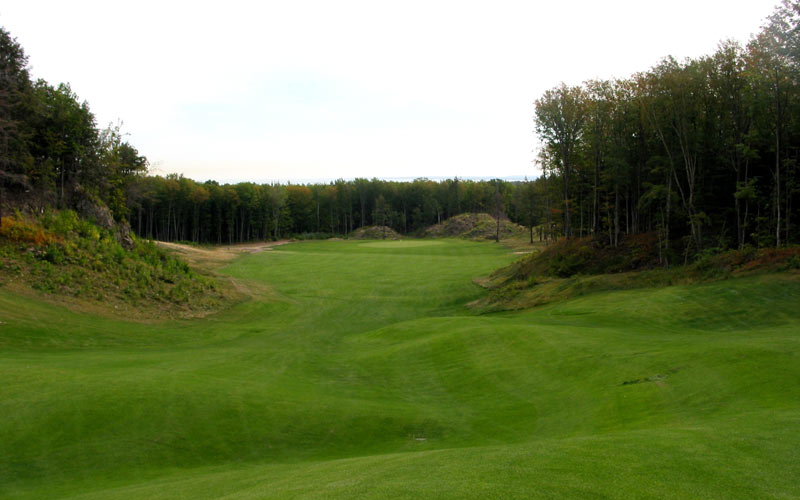
The 18th faiwary, from 280 yards out from the green. Both sides of the fairway and rough help funnel a slightly misdirected tee shot toward the center. The narrowest part of the fairway (at the bottom of the hill) is 220 yards from the green.
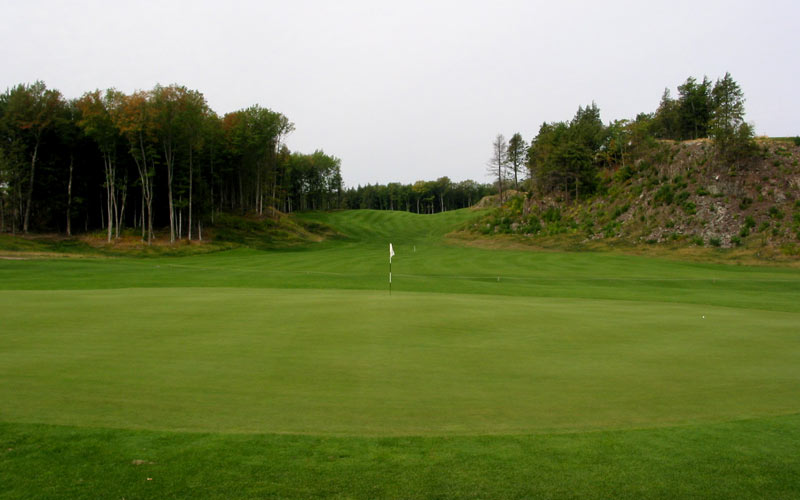
From behind the 18th: The green seems like a pool of water at the base of a cascading waterfall.
Greywalls is a throwback to the days of courses such as Cape Breton Highlands that take the player on a tour of a dramatic property, with an occasional hike thrown in, and hammer home the notion that golf is an outdoor sport.

From behind the 6th green: A typical view of Marquette, with its rugged setting and a natural hole featuring a thoughtful green.
The End


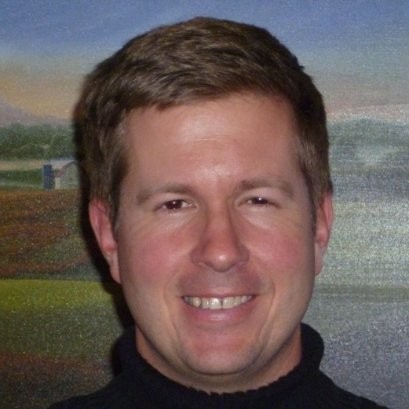


![The Park, West Palm (Lit 9) [2023]](https://golfclubatlas.com/wp-content/uploads/2024/12/IMG_7092-2-scaled-500x383.jpg)


